Evolution of Environmental Assessment and Transparency in Canada
VerifiedAdded on 2023/06/12
|5
|2182
|208
Essay
AI Summary
This essay examines the evolution and development of environmental assessment in Canada, with a particular focus on transparency and credibility within Ontario's environmental assessment program. It traces the historical progression from the early 1970s cabinet policy through the Environmental Assessment and Review Process Guidelines Order (EARPGO) to the significant transformations introduced in 2012. The essay discusses the implementation of Environmental Assessment (EA) as a tool for advancement planning and decision-making, highlighting reforms in federal and provincial EA systems. It emphasizes the importance of considering climate change effects in project planning, especially in regions like Northern and Western Ontario. Furthermore, the essay addresses criticisms of Ontario's environmental assessment program, particularly regarding transparency, public involvement, and the integration of climate change mitigation strategies, while also pointing out the agreement between Ontario and Canada on EA cooperation. Desklib offers a platform to explore more such documents and study resources.
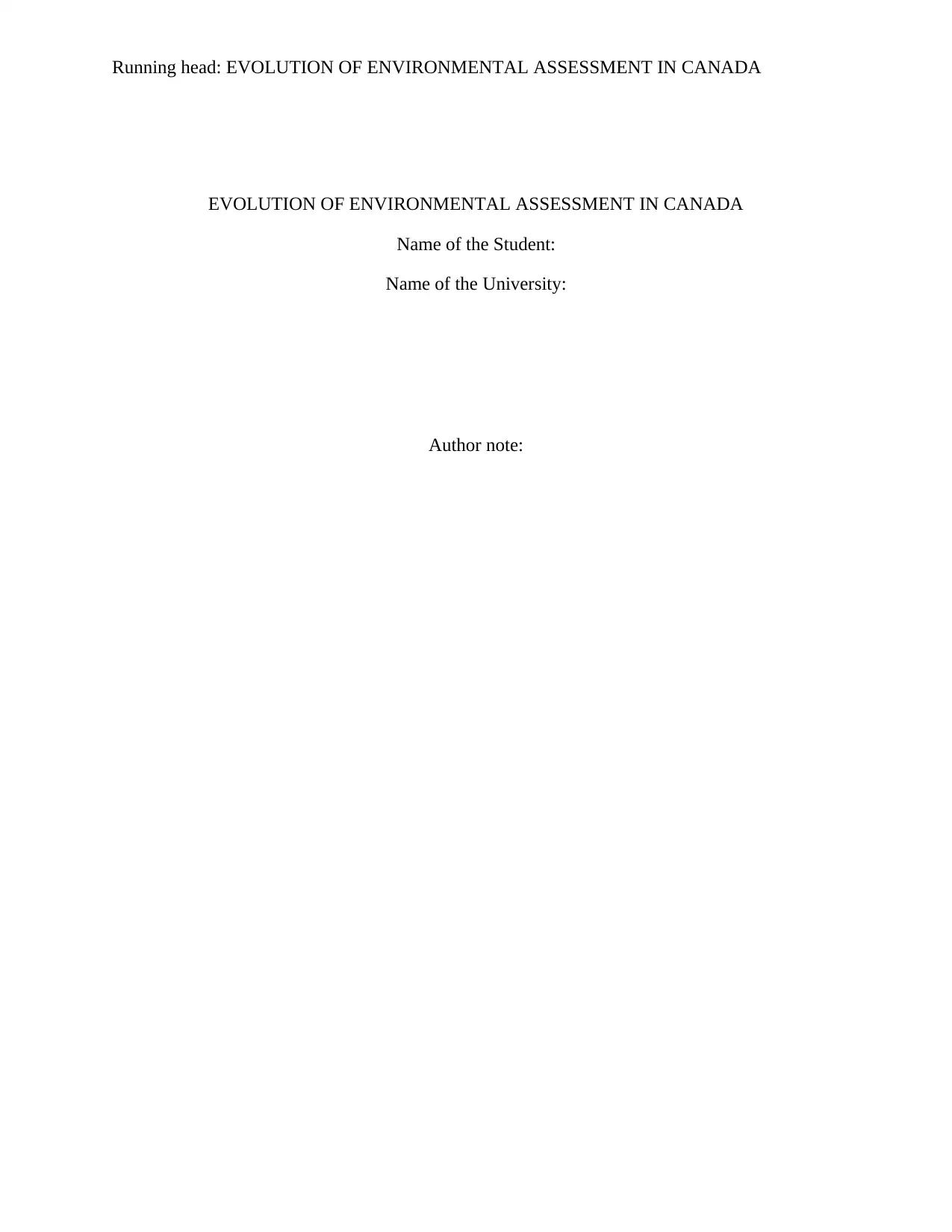
Running head: EVOLUTION OF ENVIRONMENTAL ASSESSMENT IN CANADA
EVOLUTION OF ENVIRONMENTAL ASSESSMENT IN CANADA
Name of the Student:
Name of the University:
Author note:
EVOLUTION OF ENVIRONMENTAL ASSESSMENT IN CANADA
Name of the Student:
Name of the University:
Author note:
Paraphrase This Document
Need a fresh take? Get an instant paraphrase of this document with our AI Paraphraser
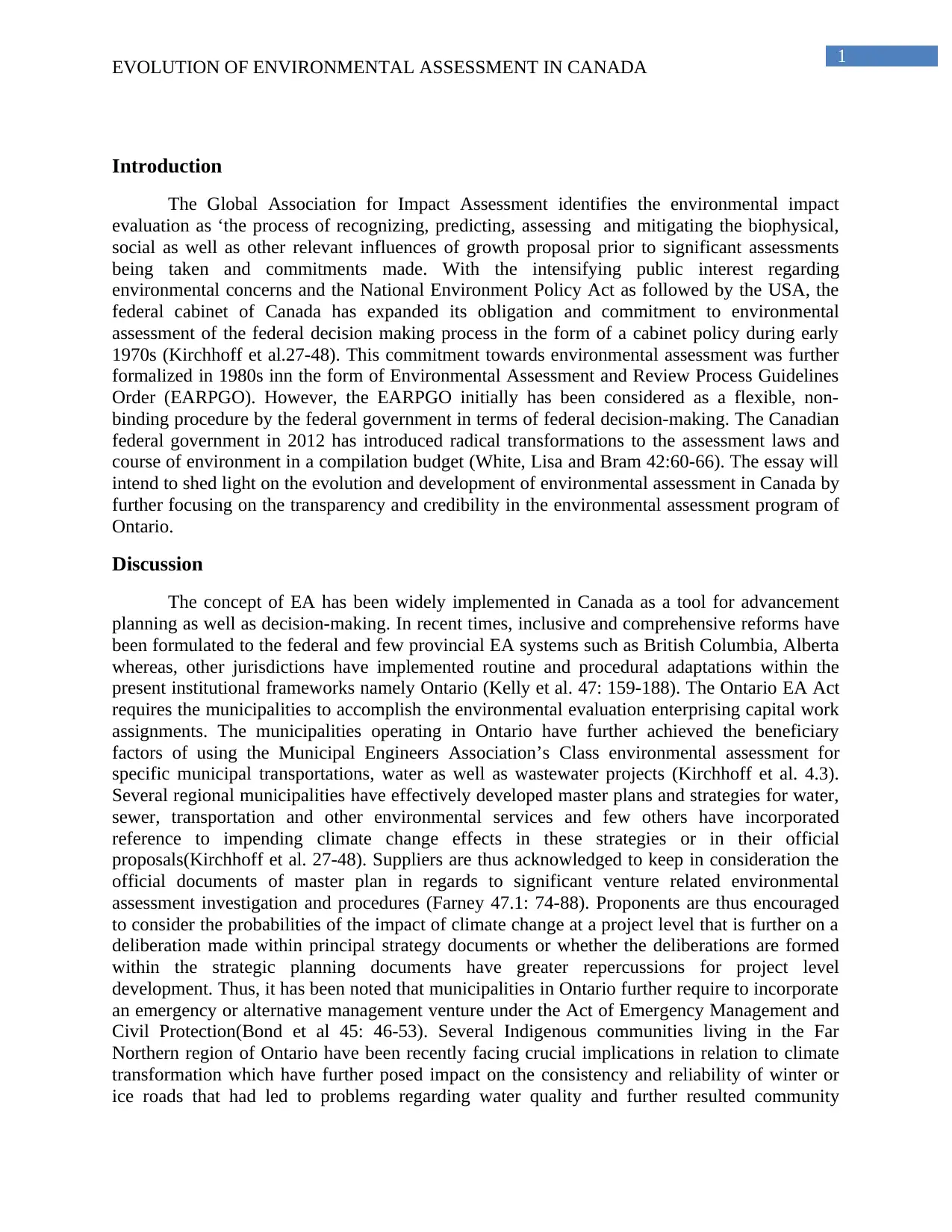
1
EVOLUTION OF ENVIRONMENTAL ASSESSMENT IN CANADA
Introduction
The Global Association for Impact Assessment identifies the environmental impact
evaluation as ‘the process of recognizing, predicting, assessing and mitigating the biophysical,
social as well as other relevant influences of growth proposal prior to significant assessments
being taken and commitments made. With the intensifying public interest regarding
environmental concerns and the National Environment Policy Act as followed by the USA, the
federal cabinet of Canada has expanded its obligation and commitment to environmental
assessment of the federal decision making process in the form of a cabinet policy during early
1970s (Kirchhoff et al.27-48). This commitment towards environmental assessment was further
formalized in 1980s inn the form of Environmental Assessment and Review Process Guidelines
Order (EARPGO). However, the EARPGO initially has been considered as a flexible, non-
binding procedure by the federal government in terms of federal decision-making. The Canadian
federal government in 2012 has introduced radical transformations to the assessment laws and
course of environment in a compilation budget (White, Lisa and Bram 42:60-66). The essay will
intend to shed light on the evolution and development of environmental assessment in Canada by
further focusing on the transparency and credibility in the environmental assessment program of
Ontario.
Discussion
The concept of EA has been widely implemented in Canada as a tool for advancement
planning as well as decision-making. In recent times, inclusive and comprehensive reforms have
been formulated to the federal and few provincial EA systems such as British Columbia, Alberta
whereas, other jurisdictions have implemented routine and procedural adaptations within the
present institutional frameworks namely Ontario (Kelly et al. 47: 159-188). The Ontario EA Act
requires the municipalities to accomplish the environmental evaluation enterprising capital work
assignments. The municipalities operating in Ontario have further achieved the beneficiary
factors of using the Municipal Engineers Association’s Class environmental assessment for
specific municipal transportations, water as well as wastewater projects (Kirchhoff et al. 4.3).
Several regional municipalities have effectively developed master plans and strategies for water,
sewer, transportation and other environmental services and few others have incorporated
reference to impending climate change effects in these strategies or in their official
proposals(Kirchhoff et al. 27-48). Suppliers are thus acknowledged to keep in consideration the
official documents of master plan in regards to significant venture related environmental
assessment investigation and procedures (Farney 47.1: 74-88). Proponents are thus encouraged
to consider the probabilities of the impact of climate change at a project level that is further on a
deliberation made within principal strategy documents or whether the deliberations are formed
within the strategic planning documents have greater repercussions for project level
development. Thus, it has been noted that municipalities in Ontario further require to incorporate
an emergency or alternative management venture under the Act of Emergency Management and
Civil Protection(Bond et al 45: 46-53). Several Indigenous communities living in the Far
Northern region of Ontario have been recently facing crucial implications in relation to climate
transformation which have further posed impact on the consistency and reliability of winter or
ice roads that had led to problems regarding water quality and further resulted community
EVOLUTION OF ENVIRONMENTAL ASSESSMENT IN CANADA
Introduction
The Global Association for Impact Assessment identifies the environmental impact
evaluation as ‘the process of recognizing, predicting, assessing and mitigating the biophysical,
social as well as other relevant influences of growth proposal prior to significant assessments
being taken and commitments made. With the intensifying public interest regarding
environmental concerns and the National Environment Policy Act as followed by the USA, the
federal cabinet of Canada has expanded its obligation and commitment to environmental
assessment of the federal decision making process in the form of a cabinet policy during early
1970s (Kirchhoff et al.27-48). This commitment towards environmental assessment was further
formalized in 1980s inn the form of Environmental Assessment and Review Process Guidelines
Order (EARPGO). However, the EARPGO initially has been considered as a flexible, non-
binding procedure by the federal government in terms of federal decision-making. The Canadian
federal government in 2012 has introduced radical transformations to the assessment laws and
course of environment in a compilation budget (White, Lisa and Bram 42:60-66). The essay will
intend to shed light on the evolution and development of environmental assessment in Canada by
further focusing on the transparency and credibility in the environmental assessment program of
Ontario.
Discussion
The concept of EA has been widely implemented in Canada as a tool for advancement
planning as well as decision-making. In recent times, inclusive and comprehensive reforms have
been formulated to the federal and few provincial EA systems such as British Columbia, Alberta
whereas, other jurisdictions have implemented routine and procedural adaptations within the
present institutional frameworks namely Ontario (Kelly et al. 47: 159-188). The Ontario EA Act
requires the municipalities to accomplish the environmental evaluation enterprising capital work
assignments. The municipalities operating in Ontario have further achieved the beneficiary
factors of using the Municipal Engineers Association’s Class environmental assessment for
specific municipal transportations, water as well as wastewater projects (Kirchhoff et al. 4.3).
Several regional municipalities have effectively developed master plans and strategies for water,
sewer, transportation and other environmental services and few others have incorporated
reference to impending climate change effects in these strategies or in their official
proposals(Kirchhoff et al. 27-48). Suppliers are thus acknowledged to keep in consideration the
official documents of master plan in regards to significant venture related environmental
assessment investigation and procedures (Farney 47.1: 74-88). Proponents are thus encouraged
to consider the probabilities of the impact of climate change at a project level that is further on a
deliberation made within principal strategy documents or whether the deliberations are formed
within the strategic planning documents have greater repercussions for project level
development. Thus, it has been noted that municipalities in Ontario further require to incorporate
an emergency or alternative management venture under the Act of Emergency Management and
Civil Protection(Bond et al 45: 46-53). Several Indigenous communities living in the Far
Northern region of Ontario have been recently facing crucial implications in relation to climate
transformation which have further posed impact on the consistency and reliability of winter or
ice roads that had led to problems regarding water quality and further resulted community
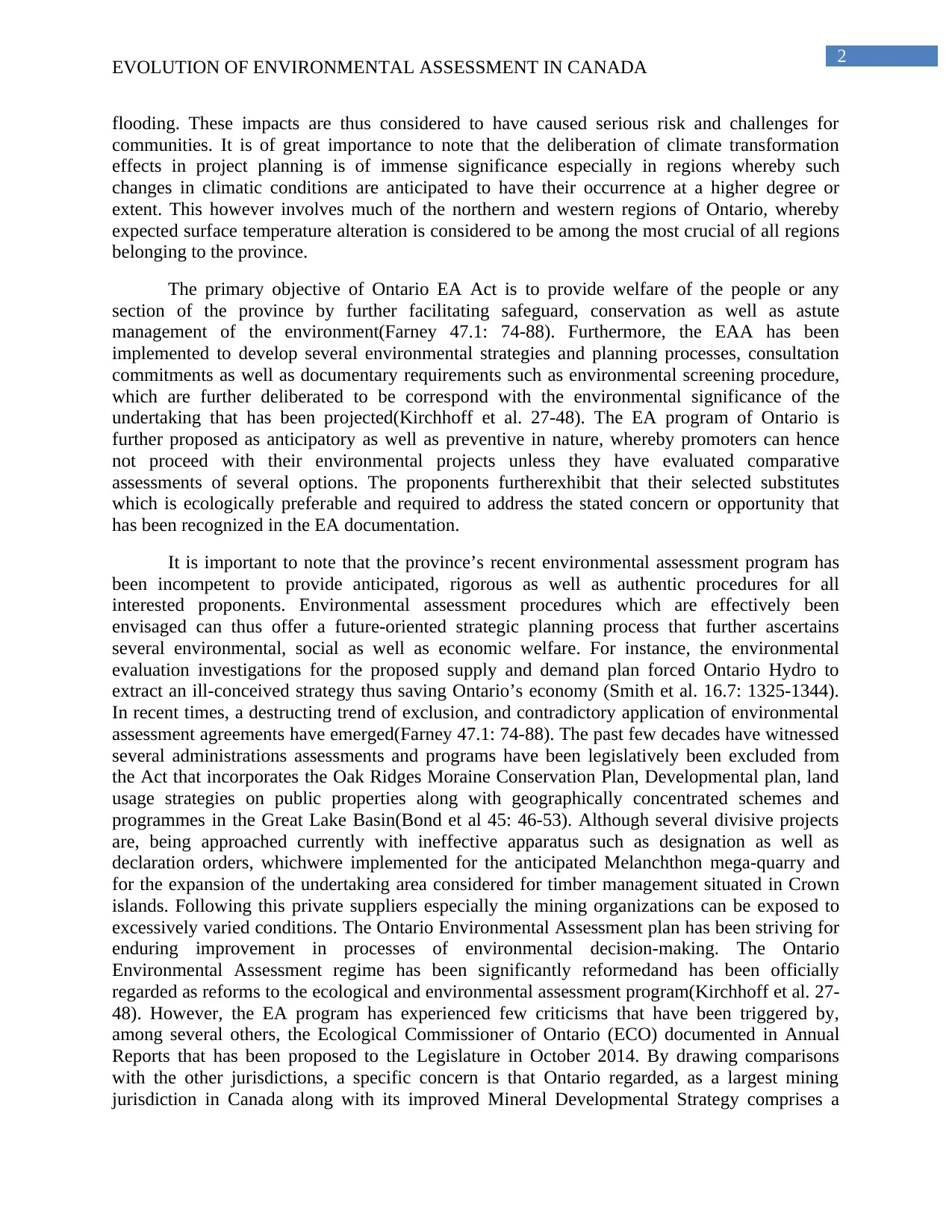
2
EVOLUTION OF ENVIRONMENTAL ASSESSMENT IN CANADA
flooding. These impacts are thus considered to have caused serious risk and challenges for
communities. It is of great importance to note that the deliberation of climate transformation
effects in project planning is of immense significance especially in regions whereby such
changes in climatic conditions are anticipated to have their occurrence at a higher degree or
extent. This however involves much of the northern and western regions of Ontario, whereby
expected surface temperature alteration is considered to be among the most crucial of all regions
belonging to the province.
The primary objective of Ontario EA Act is to provide welfare of the people or any
section of the province by further facilitating safeguard, conservation as well as astute
management of the environment(Farney 47.1: 74-88). Furthermore, the EAA has been
implemented to develop several environmental strategies and planning processes, consultation
commitments as well as documentary requirements such as environmental screening procedure,
which are further deliberated to be correspond with the environmental significance of the
undertaking that has been projected(Kirchhoff et al. 27-48). The EA program of Ontario is
further proposed as anticipatory as well as preventive in nature, whereby promoters can hence
not proceed with their environmental projects unless they have evaluated comparative
assessments of several options. The proponents furtherexhibit that their selected substitutes
which is ecologically preferable and required to address the stated concern or opportunity that
has been recognized in the EA documentation.
It is important to note that the province’s recent environmental assessment program has
been incompetent to provide anticipated, rigorous as well as authentic procedures for all
interested proponents. Environmental assessment procedures which are effectively been
envisaged can thus offer a future-oriented strategic planning process that further ascertains
several environmental, social as well as economic welfare. For instance, the environmental
evaluation investigations for the proposed supply and demand plan forced Ontario Hydro to
extract an ill-conceived strategy thus saving Ontario’s economy (Smith et al. 16.7: 1325-1344).
In recent times, a destructing trend of exclusion, and contradictory application of environmental
assessment agreements have emerged(Farney 47.1: 74-88). The past few decades have witnessed
several administrations assessments and programs have been legislatively been excluded from
the Act that incorporates the Oak Ridges Moraine Conservation Plan, Developmental plan, land
usage strategies on public properties along with geographically concentrated schemes and
programmes in the Great Lake Basin(Bond et al 45: 46-53). Although several divisive projects
are, being approached currently with ineffective apparatus such as designation as well as
declaration orders, whichwere implemented for the anticipated Melanchthon mega-quarry and
for the expansion of the undertaking area considered for timber management situated in Crown
islands. Following this private suppliers especially the mining organizations can be exposed to
excessively varied conditions. The Ontario Environmental Assessment plan has been striving for
enduring improvement in processes of environmental decision-making. The Ontario
Environmental Assessment regime has been significantly reformedand has been officially
regarded as reforms to the ecological and environmental assessment program(Kirchhoff et al. 27-
48). However, the EA program has experienced few criticisms that have been triggered by,
among several others, the Ecological Commissioner of Ontario (ECO) documented in Annual
Reports that has been proposed to the Legislature in October 2014. By drawing comparisons
with the other jurisdictions, a specific concern is that Ontario regarded, as a largest mining
jurisdiction in Canada along with its improved Mineral Developmental Strategy comprises a
EVOLUTION OF ENVIRONMENTAL ASSESSMENT IN CANADA
flooding. These impacts are thus considered to have caused serious risk and challenges for
communities. It is of great importance to note that the deliberation of climate transformation
effects in project planning is of immense significance especially in regions whereby such
changes in climatic conditions are anticipated to have their occurrence at a higher degree or
extent. This however involves much of the northern and western regions of Ontario, whereby
expected surface temperature alteration is considered to be among the most crucial of all regions
belonging to the province.
The primary objective of Ontario EA Act is to provide welfare of the people or any
section of the province by further facilitating safeguard, conservation as well as astute
management of the environment(Farney 47.1: 74-88). Furthermore, the EAA has been
implemented to develop several environmental strategies and planning processes, consultation
commitments as well as documentary requirements such as environmental screening procedure,
which are further deliberated to be correspond with the environmental significance of the
undertaking that has been projected(Kirchhoff et al. 27-48). The EA program of Ontario is
further proposed as anticipatory as well as preventive in nature, whereby promoters can hence
not proceed with their environmental projects unless they have evaluated comparative
assessments of several options. The proponents furtherexhibit that their selected substitutes
which is ecologically preferable and required to address the stated concern or opportunity that
has been recognized in the EA documentation.
It is important to note that the province’s recent environmental assessment program has
been incompetent to provide anticipated, rigorous as well as authentic procedures for all
interested proponents. Environmental assessment procedures which are effectively been
envisaged can thus offer a future-oriented strategic planning process that further ascertains
several environmental, social as well as economic welfare. For instance, the environmental
evaluation investigations for the proposed supply and demand plan forced Ontario Hydro to
extract an ill-conceived strategy thus saving Ontario’s economy (Smith et al. 16.7: 1325-1344).
In recent times, a destructing trend of exclusion, and contradictory application of environmental
assessment agreements have emerged(Farney 47.1: 74-88). The past few decades have witnessed
several administrations assessments and programs have been legislatively been excluded from
the Act that incorporates the Oak Ridges Moraine Conservation Plan, Developmental plan, land
usage strategies on public properties along with geographically concentrated schemes and
programmes in the Great Lake Basin(Bond et al 45: 46-53). Although several divisive projects
are, being approached currently with ineffective apparatus such as designation as well as
declaration orders, whichwere implemented for the anticipated Melanchthon mega-quarry and
for the expansion of the undertaking area considered for timber management situated in Crown
islands. Following this private suppliers especially the mining organizations can be exposed to
excessively varied conditions. The Ontario Environmental Assessment plan has been striving for
enduring improvement in processes of environmental decision-making. The Ontario
Environmental Assessment regime has been significantly reformedand has been officially
regarded as reforms to the ecological and environmental assessment program(Kirchhoff et al. 27-
48). However, the EA program has experienced few criticisms that have been triggered by,
among several others, the Ecological Commissioner of Ontario (ECO) documented in Annual
Reports that has been proposed to the Legislature in October 2014. By drawing comparisons
with the other jurisdictions, a specific concern is that Ontario regarded, as a largest mining
jurisdiction in Canada along with its improved Mineral Developmental Strategy comprises a
⊘ This is a preview!⊘
Do you want full access?
Subscribe today to unlock all pages.

Trusted by 1+ million students worldwide
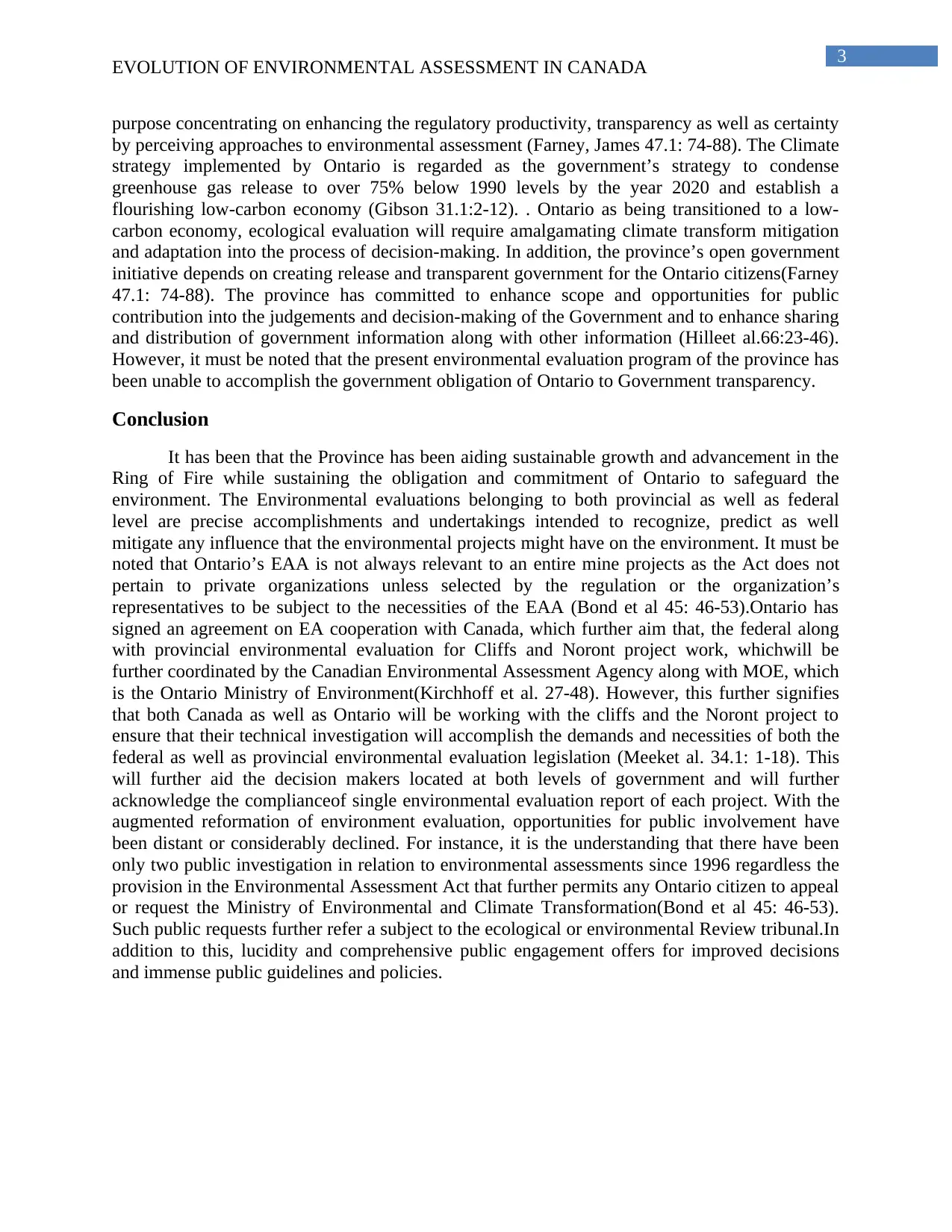
3
EVOLUTION OF ENVIRONMENTAL ASSESSMENT IN CANADA
purpose concentrating on enhancing the regulatory productivity, transparency as well as certainty
by perceiving approaches to environmental assessment (Farney, James 47.1: 74-88). The Climate
strategy implemented by Ontario is regarded as the government’s strategy to condense
greenhouse gas release to over 75% below 1990 levels by the year 2020 and establish a
flourishing low-carbon economy (Gibson 31.1:2-12). . Ontario as being transitioned to a low-
carbon economy, ecological evaluation will require amalgamating climate transform mitigation
and adaptation into the process of decision-making. In addition, the province’s open government
initiative depends on creating release and transparent government for the Ontario citizens(Farney
47.1: 74-88). The province has committed to enhance scope and opportunities for public
contribution into the judgements and decision-making of the Government and to enhance sharing
and distribution of government information along with other information (Hilleet al.66:23-46).
However, it must be noted that the present environmental evaluation program of the province has
been unable to accomplish the government obligation of Ontario to Government transparency.
Conclusion
It has been that the Province has been aiding sustainable growth and advancement in the
Ring of Fire while sustaining the obligation and commitment of Ontario to safeguard the
environment. The Environmental evaluations belonging to both provincial as well as federal
level are precise accomplishments and undertakings intended to recognize, predict as well
mitigate any influence that the environmental projects might have on the environment. It must be
noted that Ontario’s EAA is not always relevant to an entire mine projects as the Act does not
pertain to private organizations unless selected by the regulation or the organization’s
representatives to be subject to the necessities of the EAA (Bond et al 45: 46-53).Ontario has
signed an agreement on EA cooperation with Canada, which further aim that, the federal along
with provincial environmental evaluation for Cliffs and Noront project work, whichwill be
further coordinated by the Canadian Environmental Assessment Agency along with MOE, which
is the Ontario Ministry of Environment(Kirchhoff et al. 27-48). However, this further signifies
that both Canada as well as Ontario will be working with the cliffs and the Noront project to
ensure that their technical investigation will accomplish the demands and necessities of both the
federal as well as provincial environmental evaluation legislation (Meeket al. 34.1: 1-18). This
will further aid the decision makers located at both levels of government and will further
acknowledge the complianceof single environmental evaluation report of each project. With the
augmented reformation of environment evaluation, opportunities for public involvement have
been distant or considerably declined. For instance, it is the understanding that there have been
only two public investigation in relation to environmental assessments since 1996 regardless the
provision in the Environmental Assessment Act that further permits any Ontario citizen to appeal
or request the Ministry of Environmental and Climate Transformation(Bond et al 45: 46-53).
Such public requests further refer a subject to the ecological or environmental Review tribunal.In
addition to this, lucidity and comprehensive public engagement offers for improved decisions
and immense public guidelines and policies.
EVOLUTION OF ENVIRONMENTAL ASSESSMENT IN CANADA
purpose concentrating on enhancing the regulatory productivity, transparency as well as certainty
by perceiving approaches to environmental assessment (Farney, James 47.1: 74-88). The Climate
strategy implemented by Ontario is regarded as the government’s strategy to condense
greenhouse gas release to over 75% below 1990 levels by the year 2020 and establish a
flourishing low-carbon economy (Gibson 31.1:2-12). . Ontario as being transitioned to a low-
carbon economy, ecological evaluation will require amalgamating climate transform mitigation
and adaptation into the process of decision-making. In addition, the province’s open government
initiative depends on creating release and transparent government for the Ontario citizens(Farney
47.1: 74-88). The province has committed to enhance scope and opportunities for public
contribution into the judgements and decision-making of the Government and to enhance sharing
and distribution of government information along with other information (Hilleet al.66:23-46).
However, it must be noted that the present environmental evaluation program of the province has
been unable to accomplish the government obligation of Ontario to Government transparency.
Conclusion
It has been that the Province has been aiding sustainable growth and advancement in the
Ring of Fire while sustaining the obligation and commitment of Ontario to safeguard the
environment. The Environmental evaluations belonging to both provincial as well as federal
level are precise accomplishments and undertakings intended to recognize, predict as well
mitigate any influence that the environmental projects might have on the environment. It must be
noted that Ontario’s EAA is not always relevant to an entire mine projects as the Act does not
pertain to private organizations unless selected by the regulation or the organization’s
representatives to be subject to the necessities of the EAA (Bond et al 45: 46-53).Ontario has
signed an agreement on EA cooperation with Canada, which further aim that, the federal along
with provincial environmental evaluation for Cliffs and Noront project work, whichwill be
further coordinated by the Canadian Environmental Assessment Agency along with MOE, which
is the Ontario Ministry of Environment(Kirchhoff et al. 27-48). However, this further signifies
that both Canada as well as Ontario will be working with the cliffs and the Noront project to
ensure that their technical investigation will accomplish the demands and necessities of both the
federal as well as provincial environmental evaluation legislation (Meeket al. 34.1: 1-18). This
will further aid the decision makers located at both levels of government and will further
acknowledge the complianceof single environmental evaluation report of each project. With the
augmented reformation of environment evaluation, opportunities for public involvement have
been distant or considerably declined. For instance, it is the understanding that there have been
only two public investigation in relation to environmental assessments since 1996 regardless the
provision in the Environmental Assessment Act that further permits any Ontario citizen to appeal
or request the Ministry of Environmental and Climate Transformation(Bond et al 45: 46-53).
Such public requests further refer a subject to the ecological or environmental Review tribunal.In
addition to this, lucidity and comprehensive public engagement offers for improved decisions
and immense public guidelines and policies.
Paraphrase This Document
Need a fresh take? Get an instant paraphrase of this document with our AI Paraphraser
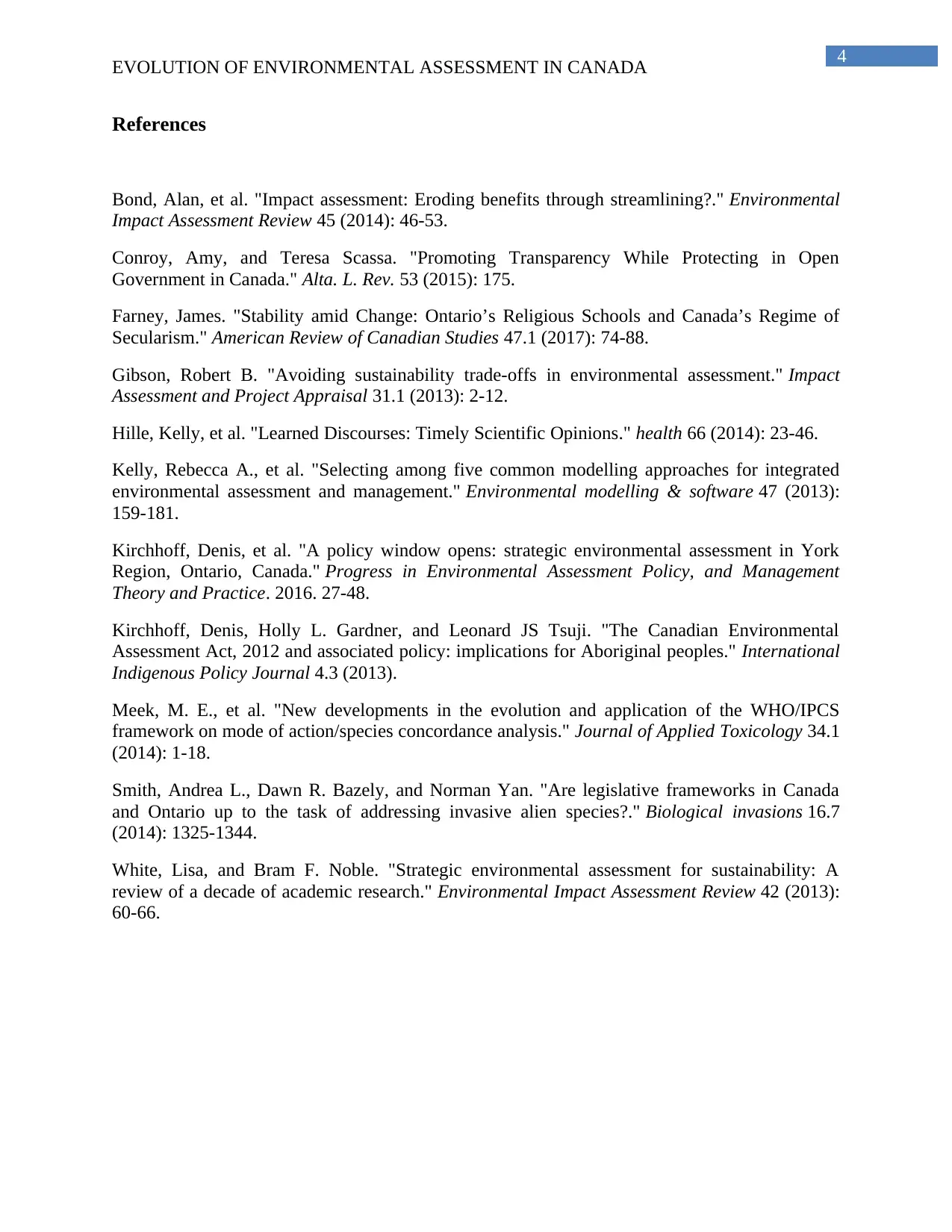
4
EVOLUTION OF ENVIRONMENTAL ASSESSMENT IN CANADA
References
Bond, Alan, et al. "Impact assessment: Eroding benefits through streamlining?." Environmental
Impact Assessment Review 45 (2014): 46-53.
Conroy, Amy, and Teresa Scassa. "Promoting Transparency While Protecting in Open
Government in Canada." Alta. L. Rev. 53 (2015): 175.
Farney, James. "Stability amid Change: Ontario’s Religious Schools and Canada’s Regime of
Secularism." American Review of Canadian Studies 47.1 (2017): 74-88.
Gibson, Robert B. "Avoiding sustainability trade-offs in environmental assessment." Impact
Assessment and Project Appraisal 31.1 (2013): 2-12.
Hille, Kelly, et al. "Learned Discourses: Timely Scientific Opinions." health 66 (2014): 23-46.
Kelly, Rebecca A., et al. "Selecting among five common modelling approaches for integrated
environmental assessment and management." Environmental modelling & software 47 (2013):
159-181.
Kirchhoff, Denis, et al. "A policy window opens: strategic environmental assessment in York
Region, Ontario, Canada." Progress in Environmental Assessment Policy, and Management
Theory and Practice. 2016. 27-48.
Kirchhoff, Denis, Holly L. Gardner, and Leonard JS Tsuji. "The Canadian Environmental
Assessment Act, 2012 and associated policy: implications for Aboriginal peoples." International
Indigenous Policy Journal 4.3 (2013).
Meek, M. E., et al. "New developments in the evolution and application of the WHO/IPCS
framework on mode of action/species concordance analysis." Journal of Applied Toxicology 34.1
(2014): 1-18.
Smith, Andrea L., Dawn R. Bazely, and Norman Yan. "Are legislative frameworks in Canada
and Ontario up to the task of addressing invasive alien species?." Biological invasions 16.7
(2014): 1325-1344.
White, Lisa, and Bram F. Noble. "Strategic environmental assessment for sustainability: A
review of a decade of academic research." Environmental Impact Assessment Review 42 (2013):
60-66.
EVOLUTION OF ENVIRONMENTAL ASSESSMENT IN CANADA
References
Bond, Alan, et al. "Impact assessment: Eroding benefits through streamlining?." Environmental
Impact Assessment Review 45 (2014): 46-53.
Conroy, Amy, and Teresa Scassa. "Promoting Transparency While Protecting in Open
Government in Canada." Alta. L. Rev. 53 (2015): 175.
Farney, James. "Stability amid Change: Ontario’s Religious Schools and Canada’s Regime of
Secularism." American Review of Canadian Studies 47.1 (2017): 74-88.
Gibson, Robert B. "Avoiding sustainability trade-offs in environmental assessment." Impact
Assessment and Project Appraisal 31.1 (2013): 2-12.
Hille, Kelly, et al. "Learned Discourses: Timely Scientific Opinions." health 66 (2014): 23-46.
Kelly, Rebecca A., et al. "Selecting among five common modelling approaches for integrated
environmental assessment and management." Environmental modelling & software 47 (2013):
159-181.
Kirchhoff, Denis, et al. "A policy window opens: strategic environmental assessment in York
Region, Ontario, Canada." Progress in Environmental Assessment Policy, and Management
Theory and Practice. 2016. 27-48.
Kirchhoff, Denis, Holly L. Gardner, and Leonard JS Tsuji. "The Canadian Environmental
Assessment Act, 2012 and associated policy: implications for Aboriginal peoples." International
Indigenous Policy Journal 4.3 (2013).
Meek, M. E., et al. "New developments in the evolution and application of the WHO/IPCS
framework on mode of action/species concordance analysis." Journal of Applied Toxicology 34.1
(2014): 1-18.
Smith, Andrea L., Dawn R. Bazely, and Norman Yan. "Are legislative frameworks in Canada
and Ontario up to the task of addressing invasive alien species?." Biological invasions 16.7
(2014): 1325-1344.
White, Lisa, and Bram F. Noble. "Strategic environmental assessment for sustainability: A
review of a decade of academic research." Environmental Impact Assessment Review 42 (2013):
60-66.
1 out of 5
Your All-in-One AI-Powered Toolkit for Academic Success.
+13062052269
info@desklib.com
Available 24*7 on WhatsApp / Email
![[object Object]](/_next/static/media/star-bottom.7253800d.svg)
Unlock your academic potential
Copyright © 2020–2025 A2Z Services. All Rights Reserved. Developed and managed by ZUCOL.
